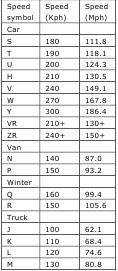215/50 R15 91V E4
1. “215” – Width of the tyre in mm from sidewall to sidewall.
2. “50” – Called the aspect ratio. This gives the height of the tyre sidewall as a %
of the width of the tyre. In this case it is 50% of 215 mm.
3. “R” – Denotes radial construction. (“B” indicates bias ply)
4. “15” – The diameter of tyre’s rim in inches.
5. “91” – Maximum load capacity of the tyre (see load table below)when
properly inflated. In this case it is 615 Kg.
6. “V” – Indicates the maximum service speed of the tyre at full load (see speed
table below). In this case it is 240 Kmph.
7. “E4” – ECE type approval mark for sale in the European community. Other
compliant markings include “DOT” (U.S Department of Transportation),
“UTQG”(Uniform tyre Quality Grading)
Load table
The load capacity of the tyre determines what payload each tyre can carry. The table
below gives the load index and the load rating in Kg.
Generally it is advisable to rotate the tyre positions (i.e switch the tyres) so that
tyre wear is even and the life of the full set of tyres is extended. On the other hand radial
tyres should not be switched from one side to another because the cords tend to develop a
”set” due to flexing of cords during driving. Reversing the side may result in cord failure.



No comments:
Post a Comment